https://www.youtube.com/watch?v=skkDM9Ijckc
eMachines eOne - 1999 Apple iMac Knockoff
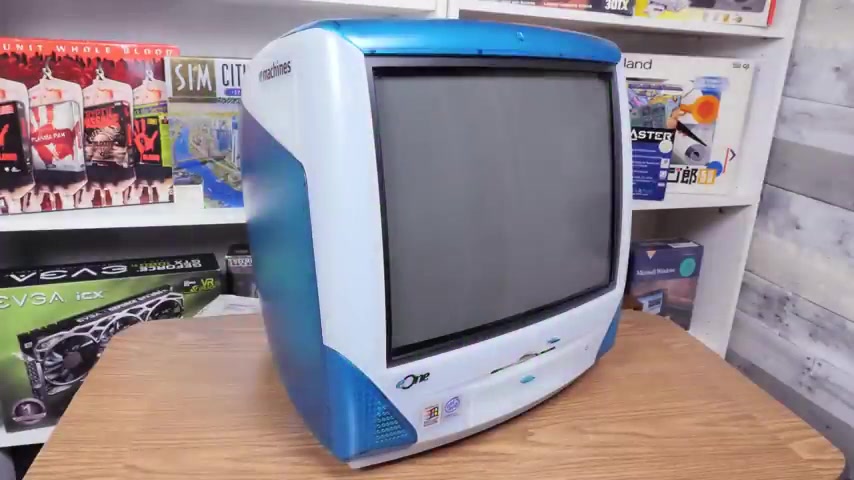
Greetings and welcome to an L G R thing .
And this is the E machines .
E 14 33 released in August of 1999 for $849 .
Although it was available for way less because that's what E machines did .
There's a $50 mail in rebate and then there was a $400 rebate .
If you signed up for three years of comp you serve 2000 dial up internet for 21 95 a month .
And yes , one of these things is not like the other , the obvious , let's state it .
This was built explicitly to cash in on the late nineties Apple imac craze complete with a not Bondy blue translucent color scheme .
Gosh , they just look so similar .
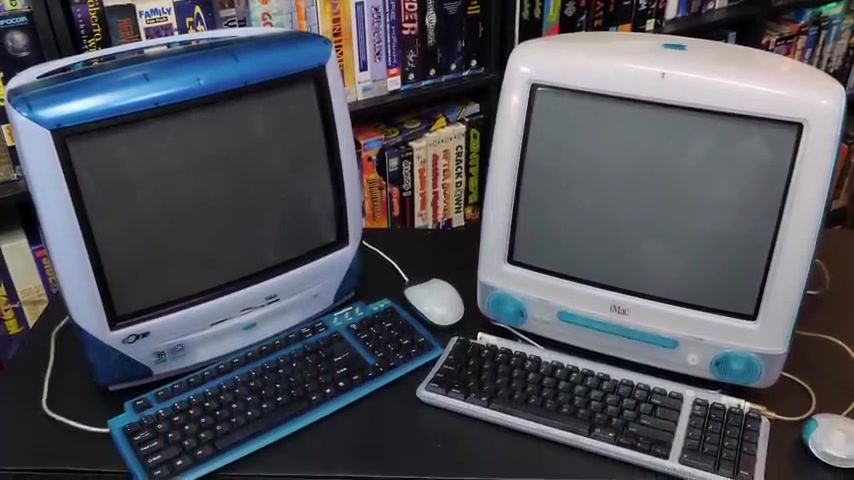
I can't tell which is the real one and which is the knock off .
And I got to give a huge thank you to Douglas for donating this .
These are not commonplace machines at all and for good reason , not only was the E one originally sold exclusively through Circuit City stores in the US , but Apple sued the crap out of them for daring to make such a blatant Imma rip off .
And that's a suit that they won and settled in March of 2000 with E machines agreeing to cease all sales of the E One as a result .
And Apple did not stop there either .
They also sued .
So tech , the Japanese firm who co developed the E One with E machines and was also selling their own version of the E ONE in Japan .
Within a month , the Tokyo District court ordered so tech to cease all production .
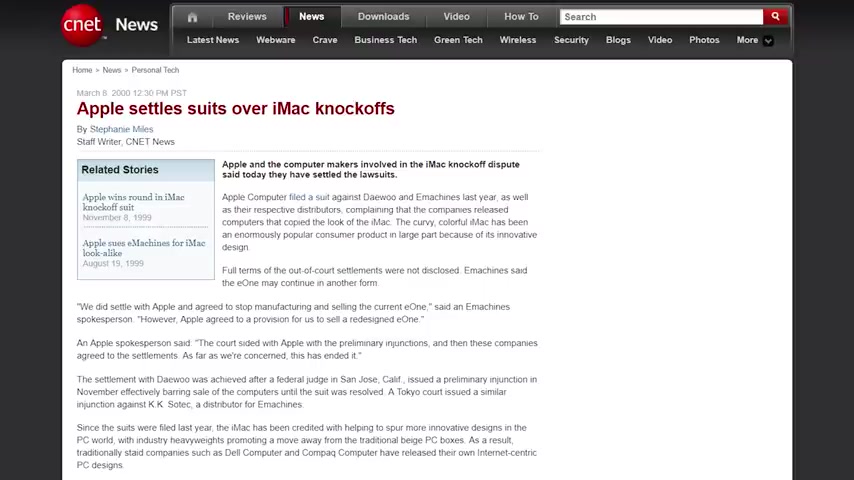
And finally , Apple also sued Korean Firm Deu due to their own imma knock off the E Power PC , all sales of the E Power PC barred by a judge in San Jose , California and Apple won a worldwide injunction against all sales of the E Power PC as well as our E machines .
E one .
So yeah , the fact that I have one of these banned things in my possession is pretty wild to me considering it was only on the market a few months and apparently didn't sell very well even when it was legal to do so .
But before Apple buried them with litigation , E machines marketed this as a computer for people who dug the aesthetic and form factor of Apple's hugely popular Bondi Blue imac but wanted to run Windows 98 instead of Mac Os nine .
It was also less costly than an IMAC by several $100 while technically including more features and higher specs .
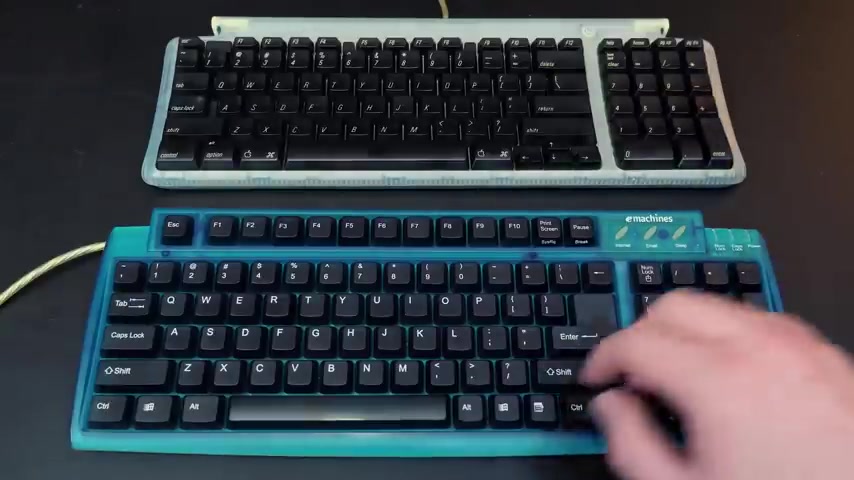
For example , you got a 433 megahertz Intel seller on processor 100 megahertz more than the 99 revision D imac as well as 64 megabytes of PC 100 S D ram twice that of the IMAC an eight megabyte A I R L A P graphics chip set .
Two more megs than the imac and a 6.4 or 8.4 gigabyte ID hard drive again up to twice that of a base model iac , they even included a keyboard that more closely resembled Apple's keyboard than anything on the PC side of things at the time , which is not a good thing .
In this case , the layout is weird and cramped and it just feels plasticky and gummy to the fingertips even compared to the Apple board , which I'm not super fond of either .
And instead of putting USB ports on each side , like the I A E machines went with dual P S two ports instead reminiscent of what Apple used to do with a DB .
You plug in a mail to mail cable on either side and then the mouse in the opposite port .

This means you can Daisy chain both devices into just one compatible P S two port if you want .
Although redundant in this case , since it has the individual ports on the computer itself , still E machines drew the line at copying Apple's famous hockey puck mouse .
Thank goodness , I don't have the original mouse from the E one , but you can see what it looks like here .
It's just a stylized mouse to fit with the rest of it .
I actually ran across this Kensington mouse that looks like it was made for the E one at Goodwill a while back .
So that's what I'll be using here .
This color scheme of translucent dark teal was just super popular at the time .
And then one of the biggest boasts of the E one was that it had a 3.5 inch floppy disk drive , a feature which the IMAC famously omitted due to them betting on the future being USB , a future Apple was correct about .
But hey , the E one has USB and a floppy drive .
So that means it's better , right ?
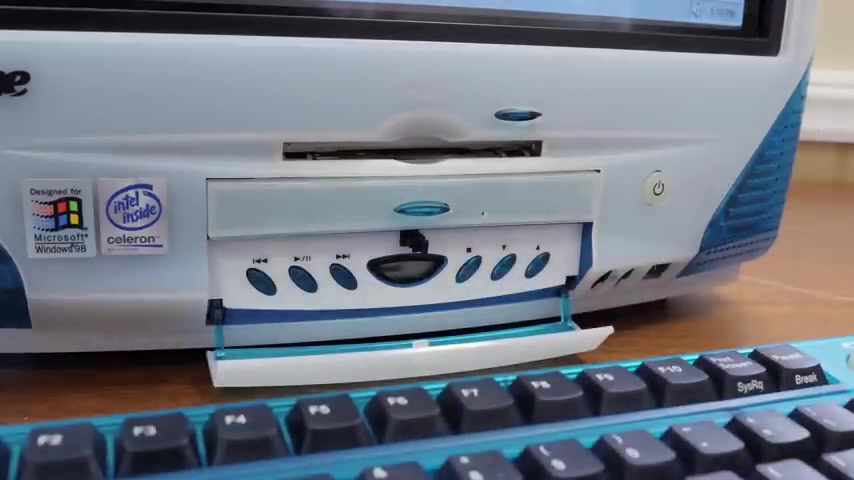
And at least it had a 24 speed CD ROM drive , although with a nonmotorized tray , not as impressive as the fancy slot loading mechanism of the late 1999 I A .
But hey , the imac didn't have this chin pop out panel that reveals CD player controls with a monochrome L CD panel .
How's that for some late nineties technological curb appeal or what about this little spot for connecting 3.5 millimeter audio jacks and a USB device in the front or around to the right side where you see these composite video inputs ?
Yeah , that's right .
The E one has a video capture capability .
There's no tuner , so you'll need something with a composite output .
So V C R s or cable TV boxes or a game console ?
Yeah , that's right .
You want to plug in your Sega Genesis to your E machines .
E one you can do that .
Resolution is not great and the colors are severely washed out .
But hey , it's here and it's pretty awesome .
Actually .
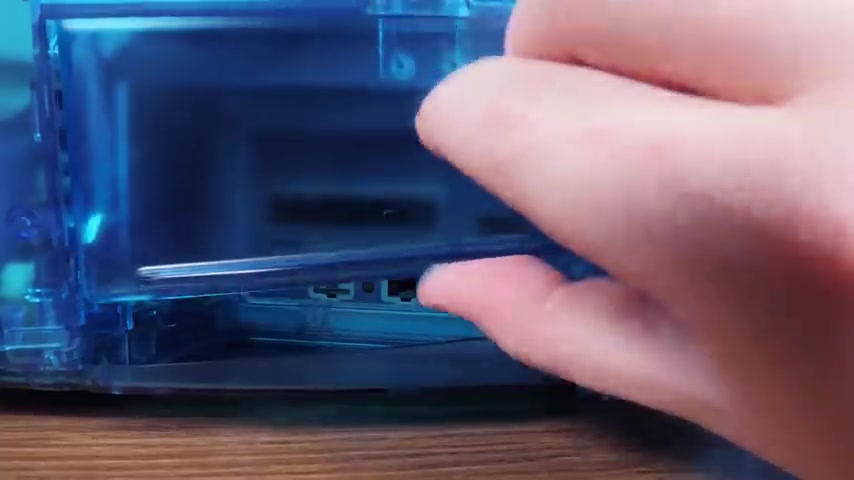
Also on this right hand side of the machine underneath a sliding panel , you even got some expand ability , an elusive thing in all in ones like this .
Granted , it came in the form of PC M CIA slots normally seen on laptops .
So upgrade options were kind of limited .
But yeah , this is also where you'll find the I O section for things like 10 base T Ethernet A 56 K modem and FAX connection R S 2 32 serial port , another USB port , two P S two ports and speaker output for the series logics , S 42 80 sound chip that is supposedly sound blaster 16 compatible , but more on that in a moment .
And finally around the back of the machine next to the power , you get a parallel port for printers and such and a 15 pin game port for joysticks or connecting external midi devices .
E machines also imitated the carrying handle on top like the IMAC but it's pretty awful .
It's made of cheap plastic with sharp edges , that kind of feel like it'll slice your hand and every time you lift it up , it detaches itself from the plastic on the front of the case .
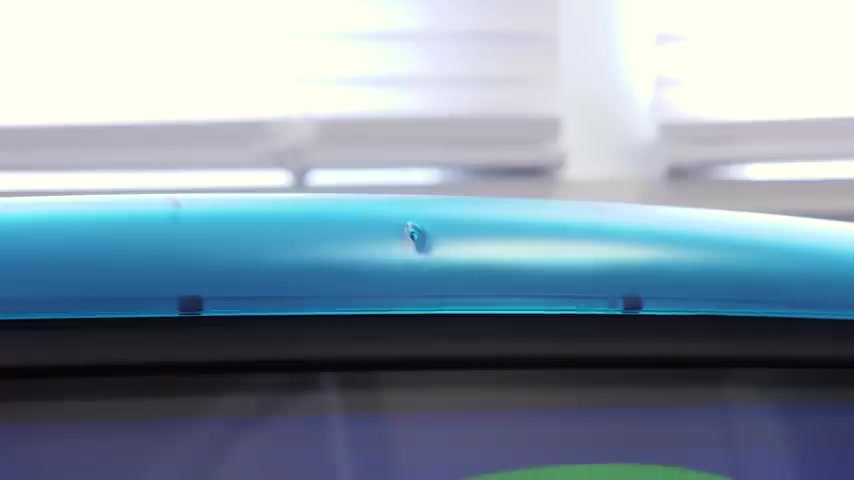
I'm gonna to hazard a guess and say build quality was not on the agenda .
There's also this terrible little microphone built into the top of the monitor housing and yeah , just check it out .
This thing is it's not good testing this crappy microphone , testing this crappy microphone still shoddy quality .
Aside , you got what appeared on paper to be a fine list of features housed in an attractive case that included a 15 inch C RT and stereo speakers .
A rather soft C RT with lackluster color reproduction and speakers that sound cheap and tinny .
But yeah , an attempt was made .
Speaking of speakers , let's talk about sound .
You know , the sound blaster 16 compatibility I mentioned , well , it's kind of here just listen to it trying to play Duke Newcomb three D's theme song .
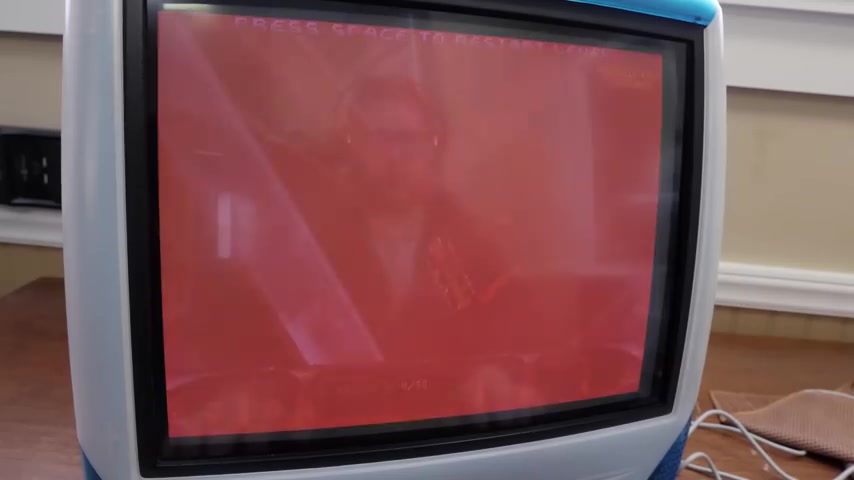
Well , in case you didn't notice it's missing half the notes .
That's awkward that it is at least pretty decent at doing PC M sound effects through sound blaster emulation .
But when I use this , I swear you can hear a Yamaha engineer crying somewhere in the distance .
This is seriously one of the worst F M synth emulations I've ever heard .
Just listen to Canyon dot mid .
Uh And now in case you're wondering , it does not have any general Midi or wave table audio on board or at least if it is the drivers that this one came with , do not support it .
But as you saw the connection earlier , you can connect external midi devices if you really wanted to .
Also interesting is that there are zero monitor controls on the case .
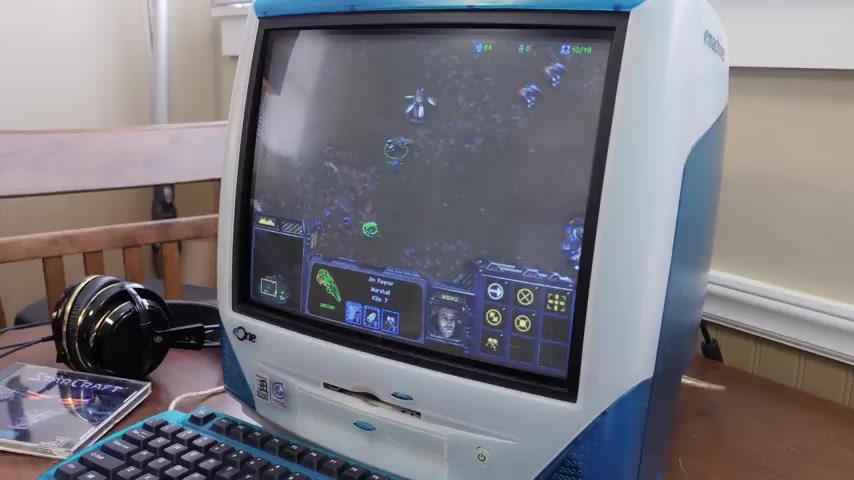
You have to do all the color brightness and geom adjustment through a control panel plug in .
That's not the most unusual thing , but even the DE Gaus is done through software .
That's something I've never seen before .
And yet , despite a lot of crap , I mean , as far as late nineties Windows games and software , it runs that stuff pretty ok .
At least for a 433 megahertz seller on with an integrated eight meg A T I R card .
See , you know , games like Starcraft are totally fine games like Quake three or not , but it's playable .
So that's something , it was also available with a 500 megahertz C P U .
So assuming it's not so to the board or something stupid like that , I guess you could upgrade this thing .
But that's something that I'm not going to dare doing .
I tried opening this up and it was an absolute nightmare .
It's almost like you had to destroy parts of it to get to what you really wanted to do .
It's not personally worth it to me to bother with that .
So 433 Megahertz it is and that is the E machine's E one .
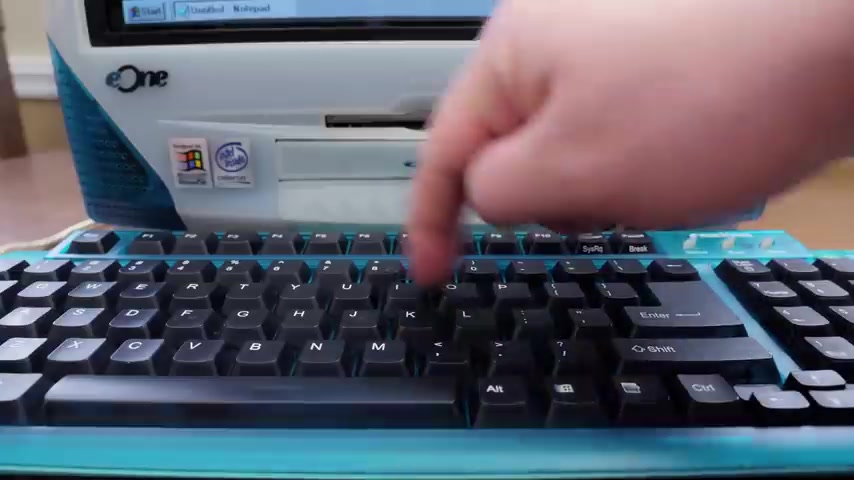
What a piece of junk , but an incredibly fascinating piece of junk with a tarnished , legally dubious legacy .
And , you know what , I'm just kind of partial to this translucent colored plastic that happened on several computers and technology products of the time .
It's admittedly cheesy and maybe even a bit off putting , but at the same time , oddly attractive and very much nostalgic , you know , I just like all in ones so I like messing with this thing .
And , uh , yeah , that's about it .
I got no excuses .
I'm just weird .
Speaking of weird , there was a follow up of sorts for the E one by Gateway who purchased E machines in 2004 .
And I guess they liked the name and the idea .
So they released the Gateway one in 2007 .
And thankfully , this didn't seem to infringe on any other IMAC trademarks or design disputes or anything like that because it was sold and forgotten .
And , uh , well , that's not a happy ending either .
But anyway , that's all for this video .
And I hope that you enjoyed watching what you just did .

I always like taking a look at bizarre computers from the past and just talking about them if I can get my hands on them .
And I've got a lot more to talk about in the future .
So stick around .
There are new videos every Monday and Friday here on L G R .
And as always , thank you very much for watching .
Are you looking for a way to reach a wider audience and get more views on your videos?
Our innovative video to text transcribing service can help you do just that.
We provide accurate transcriptions of your videos along with visual content that will help you attract new viewers and keep them engaged. Plus, our data analytics and ad campaign tools can help you monetize your content and maximize your revenue.
Let's partner up and take your video content to the next level!
Contact us today to learn more.